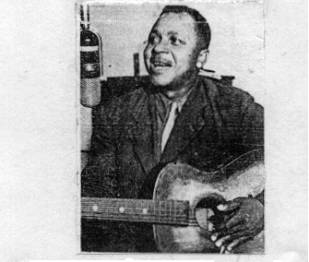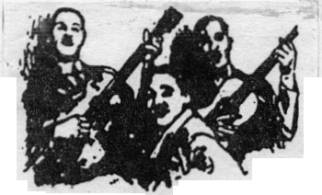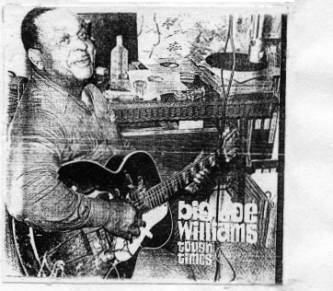
Painting © 2004 Loz
Arkle
Website
© Copyright 2000-2011 Alan White - All
Rights Reserved
Site optimised for Microsoft Internet Explorer



"Baby Please
Don't Go (Origins of a Blues)"
by Max Haymes
There
can’t be many blues / R ’n B bands who neither feature this song in their
act or at least know it. Even people on the edge of the blues world can hum the
melody or sing one verse. In the 1950’s it appeared in a film about the Deep
South called “Baby Doll” (adapted from a Tennessee Williams play, I think).
The only highlight, apart from Carol Baker’s legs! was the unidentified harp
player sitting by a fence and singing a very creditable couple of verses to
his excellent harmonica accompaniment.
In
the ‘60s blues boom many bands in the U.K. started to perform the song and
some recorded it. Most notable were the
Rolling Stones and the Animals. Of course much later on, the fine and frenetic
version by Them injected new life into “Baby Please Don’t Go”.
The
inspiration for this article came from a question posed by a drummer in a
local R ’n B outfit: “Who did “Baby Please Don’t Go’ in the first
place?” and a suggestion from my friend and slide guitarist Roger Higgins to
trace the origins of some well-known blues numbers. So here goes.
 The
blues,” Baby Please Don’t Go” was first recorded by Mississippi’s
Poor/Big Joe Williams in the autumn of 1935 for Victor’s cheap-priced Bluebird
label. This was William’s second session on record, having cut a largely solo
one in the early part of the same year, But here he is backed by
Chasey
Collins on fiddle and “Kokomo” on washboard to give a decidedly rural and
‘archaic’ feeling to the piece.
The
blues,” Baby Please Don’t Go” was first recorded by Mississippi’s
Poor/Big Joe Williams in the autumn of 1935 for Victor’s cheap-priced Bluebird
label. This was William’s second session on record, having cut a largely solo
one in the early part of the same year, But here he is backed by
Chasey
Collins on fiddle and “Kokomo” on washboard to give a decidedly rural and
‘archaic’ feeling to the piece.
Poor
Joe Williams at one of his 1935 recording sessions.
1.
“Now baby, please don’ t
go,
Now
baby please don’t go.
Baby, please don’t go back to New Orleans
an’ get your cold ice cream”.
2.
“I believe it - a man done gone,
I believe it - a man done gone.
I believe it - a man done gone to the county farm,
now with his long chain on”.
3.
“Turn your lamp down
low,
You
turn your lamp down low.
Turn your lamp down low, I cried all night long,
‘now baby please don’t go’”.
4.
“I begged you night
before,
I begged you night before.
Begged you night before, turn your lamp down low,
‘now baby, please don’t go’”.
5.
“I believe my baby’s done lyin’,
I believe my baby’ s done lyin’.
I believe my baby she’s lyin’
says she didn’t have a man,
now while I had my time”.
6.
“Fo’ I be your dog,
Spoken: “Play it”.
Ah! fo’ I be your dog.
Fo’ I be your dog, I’d pack my trunk this mornin’, baby,
go back to rollin’ fog”.
7.
“I believe I’ll leave here,
I believe I’ll leave you
here.
I believe I’ 11 leave you here,
‘cos you got me way up here
an’ you don’ t feel my care”.
8.
“Now baby please don’t
go,
Oh! baby, please don’ t go.
Ah! Baby, please don’t go, back to New Orleans,
you know I love you so”.
9.
“I believe you’re tryin’ to leave me here,
Try to leave your daddy, here.
Try to leave your daddy, here, you
got me way down here
an’ you don’ t feel my care”.
(1)
Some
of the more familiar verses are included in an earlier form, but still
recognisable. Joe seems a little unsure of himself maybe his first time playing
in a group, and the answering line to the opening verse is replaced with the
more familiar one in verse 8. The “rollin’ fog” in verse 6 refers to
Joe’s home in Crawford, Mississippi. which was on the edge of the Knoxford
Swamp and would often be enshrouded in mists. He had 2 more studio sessions
before recording his second version of this song, both with a small group. In
December, 1941, he called it “Please Don’t Go”. By now Joe was really at
home working with other musicians and he oozes confidence as he encourages
John Lee ‘Sonny Boy’ Williamson in the break. The mood of the piece has
shifted to a definite urban one with the latter’s superb harp and the swinging
bass cano (a kind of imitation bass) of Alfred Elkins. With this version of
“Baby Please Don’t Go”, the listener can easily recognise the move to
electric instruments and how the number is a natural for R ’n B bands in the
50’s, 60’s, etc.
1.
“Ah! baby ,
please don’ t go,
Baby, please don’t go.
Baby, please don’t go back to New Orleans
you know I love you so.”
2.
“Turn your lamp down
low,
Turn your lamp down low.
Turn your lamp down low, now baby, all night long,
now baby please don’t go.”
3.
“I believe a man done gone,
I believe a man done gone an’ left (for) the county farm,
he got his shackles on.”
4.
“Baby ,please don’t
go,
Baby, please don’t go.
Baby, please don’ t go back to New Orleans,
you ??”
5.
“Afore I be your dog,
Afore I be your dog,
I git you way down here,
I make you walk the log.”
6.
“You got me way down
here,
You got me way down here.
You got me way down here by a rollin’ fog, you treat me like a dog;
baby please don’t go.”
7.
“Don’t call my
name,
Don’t call my name.
Don’t call my name, you got me way down here,
wearin’ a ball an’ chain.”
Spoken:
“Look here.”
8.
“Baby please don’t
go,
Baby please don’t go.
Baby, please don’t go back to New Orleans.....”(2)
As
can be seen, Joe has “firmed up” the lyric structure and moved verse 8 of
the 1935 blues to the opener here. By concentrating more on a general sense
of mistreatment by his partner, and the county farm, the singer delivers the
verses so familiar to our ears; incidentally, dropping one verse off
altogether. The “walk the log” verse (verse 5) appears for the first time,
on this outing.
Although
the song is “...extant in many versions” (l), it was, surprisingly, rarely
recorded before 1942: the pre-war blues era. Some of the prolifically recorded
artists who could easily have adapted the song for black urban tastes in the
1930s, such as Memphis Minnie, Big Bill, Jazz Gillum or Tampa Red, seemed to
ignore the song: at least on their recordings. However, a couple of
“covers” did crop up on wax between Joe William’s 2 recording dates
already
discussed (1935 and 1941) which included the first version of the song on
disc.
The
first one occurred almost a year after “Baby Please Don’t Go” hit the
record stores. In September, 1936, a singer known only as “Tampa Kid” cut
the song under the same title (unheard by me) in Chicago for Decca Records.
Constituting one-half of his recorded output, the only detail we know is that
“This singer gives a passable imitation of Tampa Red” (2). Perhaps this is
why he disappeared into obscurity so quickly.
An
artist who is better known, Leonard Caston, recorded his “Baby Please
Don’t Go” incorporating the “walk the log” verse into his title some
18 months prior to Joe Williams second version of the song. Caston, usually a
guitarist and pianist associated with the ‘slick’ harmonising blues with
the Five Breezes (whose recording session in 1940 marked the debut on wax, of
bass man/songwriter Willie Dixon) and the Big Three Trio in post-war years, is
surprisingly ‘raw’ and unsophisticated. An unidentified washboard player
supplies a choppy rhythm to Caston’s guitar and vocal:
1.
“Gonna walk your
log,
Gonna walk your log:
If I ever get you back to rolling fog,
I’m gonna walk your log.”
2.
“Oh ~ your bread ain’t done.
Oh! your bread ain’t done:
Well, I like them ways you cook your
cabbage greens,
But your bread am’ t done.”
3.
“You down in Natchez
town,
You down in Natchez town:
Well the girl I love she love to run around,
She down in Natchez town.”
4.
“Gonna cut ‘er
head,
Gonna cut ‘er head:
I mean that man’s about to lie down here,
I’m gon’ cut ‘er head.”
5.
Repeat verse 1.
6.
“Down in New
Orleans
Down in New Orleans:
Well the girl I love she take the cold ice cream,
She down in New Orleans.”
7.
Repeat verse 1. (3)
Although
Caston as “Baby Doo” omitted the title verse of “Baby Please Don’t
Go” he retains Joe’s opening verse from the 1935 recording. He further
establishes links with this version by his use of a washboard player, and
leaving out all references to the county farm, long chain, etc. Caston
concentrates on the mistreating woman. This includes the culinary symbolism
for her art at making love in verse 2. While reference to Natchez reminds the
listener of his Mississippi origins (he was born near Hattiesburg, Miss. in
1917 and died “22 August 1987 Minneapolis, Minnesota”,
(4)).
Baby, Please Don’t Go” is often associated with Poor/Big Joe Williams (in 1963,Paul Oliver credited him with composing it) who recorded several post-war versions of the song. But both he and “Baby Doo” Caston drew on a group of earlier blues songs: “Alabama Bound”/Elder Greene’s In Town”/ “Don’t Leave Me Here”. Oliver reports that a Texas collector “published.. . an “Alabama Boun’” with Elder Green verses, which he dated from 1908.” (5). As Oliver notes,
in 1925, banjoist Papa Charlie Jackson’s “I’m Alabama Bound” showed the links between all three titles. “Elder Greene” would be featured on later recordings by Blind Lemon Jefferson Charlie Patton(1920s) and in 1958 by Mississippi singer/guitarist “Cat-Iron”. “Alabama Bound” was recorded by Leadbelly in 1935 and 1940 and cropped up c.1956 by Lonnie Donegan during the British skiffle craze! Whilst “Don’t Leave Me Here” was first recorded in 1927 by a Mississippi group who were sometimes billed as “Sunny Boy And His Pals” or “Long Cleve Reed” and “Little Harvey Hull”. Tampa Red and Georgia Tom backed each other’s vocals on “Mama Don’t Leave Me Here” (1931) and “Don’t Leave Me Here”(1932), respectively; but are 2 versions of an unrelated blues.

Washboard
Sam recorded “Don’t Leave Me Here” in 1938 again unheard by me but is
probably an urbanised version of the Long Cleve Reed title or of “Baby Please
Don’t Go”. The melody from this group of songs was utilised and speeded up
with a more aggressive approach to the vocal. Indeed, Big Joe William’s first
postwar version of “Baby Please Don’t Go” was titled “Don’t You
Leave Me Here”, made in 1947. Though the string bass of Ransom Knowling and
the drums of Judge Riley have been added to Sonny Boy’s harp, giving a
‘Chicago blues’ feel to the song Joe himself, curiously, harks back to many
of the lines of his 1935 recording with fiddle and washboard. These include the
reference to “his long chain on” and “my baby’s done lyin’.’ Joe
substitutes the phrase ‘don’t you leave me here’ for ‘baby please
don’t go’ and changes the Southern locale of New Orleans for the more
relevant one of Chicago, where he cut this track.
But
it was not the Chicago blues giants like Muddy Waters, Howling Wolf, Little
Walter, Elmore James, etc. who kept the song alive in the earlier post-war
years. It was left to singers of the older rural blues styles. Like Delta
bluesman Bukka White who first recorded in 1930 but didn’t cut “Baby Please
Don’t Go” until 1963 for John Fahey’s Takoma label. In the same year, Big
Joe re-recorded it as “Don’t You Leave Me Here” in Copenhagen, with just
his nine-string guitar, on Storyville. Both of these were on album (L.P.)
releases.  In
the late 1970s, Georgia blues singer William Robertson recorded (also on L.P.)
a dark and in tense “Baby Please Don’t Go” with bottleneck guitar for
Flyright. This was one of Robertson’s “unique adaptations of commercial
recordings” (6). On the same album, Bastin informs us that John Lee
Ziegler, sane 7 years younger than Robertson (b.1929), “performed. . .BABY
PLEASE DON’T GO in 1951”(7).
In
the late 1970s, Georgia blues singer William Robertson recorded (also on L.P.)
a dark and in tense “Baby Please Don’t Go” with bottleneck guitar for
Flyright. This was one of Robertson’s “unique adaptations of commercial
recordings” (6). On the same album, Bastin informs us that John Lee
Ziegler, sane 7 years younger than Robertson (b.1929), “performed. . .BABY
PLEASE DON’T GO in 1951”(7).
Big Joe + 9-string ‘axe’ on cover of Arhoolie L.P. 1961.
This
was at an annual Fort Valley Ham and Eggs Festival held in southern Georgia
featuring black sacred and secular music from 1940 to the middle 1950s. It was
incorporated into a rural agricultural show run by the local black teachers’
college , which had been going since
1915. Not until British groups in the 1960s (the Stones, etc.) picked it up, did
“Baby Please Don’t Go” become a popular vehicle for contemporary blues and
r ’n b bands.
References
1.
Neil Slaven. Notes to “Crawlin’ Kingsnake” L.P. R.C.A. International
(Camden). INT 1087. 1970.
2. R.M.W.Dixon & J.Godrich. “Blues & Gospel Records 1902-1943”
(3rd.Ed.) Storyville. 1982. p.721.
3. “I ‘m Gonna Walk Your Log”. Baby
Doo vo. prob. gtr.:unk. wbd. 4/6/40. Chicago.
4. Colin Larkin (Ed.). “The Guinness Who’s Who Of Blues”. Guinness
Publishing. 1993. p.73.
5. Paul Oliver. “Songsters &
Saints” Cambridge University Press. 1984. p.116.
6. Bruce Bastin. Notes to “Georgia Blues Today”. L.P. Flyright FLY 57 1981.
7. Ibid.
Copyright © 2001 Max Haymes.
All rights reserved.




